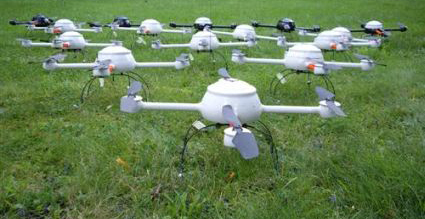The new ‘Police Air Force’
October 9, 2012
How the UK’s new Police Chief is promoting the civil use of drones amid pan-European calls for UAV liberalisation.
This month sees the launch of the National Police Air Service (NPAS) a new cross-boundary cost-saving venture that joins all of the UK’s regional police air capabilities into one umbrella organisation – in effect a new national police air force. The objective of the NPAS is to allow faster, cheaper and more efficient coordinated helicopter response across the country
How to down a drone…
February 11, 2010
“If you’ve done nothing wrong… you have nothing to fear.”

This year a UK Home Office backed coalition of regional Police Authorities will embark on a project to extend their national surveillance network by deploying unmanned airborne surveillance drones across the country. It’s planned that in the build up to 2012 the drones will be used to foil potential terrorist attacks, detect illegal immigration planning to cross the channel (by flying over France?), monitor anti-social behaviour and public order situations (demonstrations) and of course to gather intelligence on subversive activities.
The introduction of these drones represents a significant expansion of the surveillance state, planned and delivered by un-democratic consortium of police authorities and loosely regulated by vague and rarely tested laws. With this expansion of the surveillance state should come an equal counter-response probing the legal and practical boundaries of surveillance:
What methods can be used to disrupt or destroy drone technology?
Musical roads of the world.
January 19, 2009

Steen Krarup Jensen and Jakob Freud-Magnus building the Asphaltophone
how to be invisible
January 11, 2009

I’ve always been of the opinion that people over concerned with surveillance and data security are displaying the first stages of clinical paranoia. It’s well known, for those that care to look, that the UK police and military have in their possession technology which enables them to track individuals movements visually and electronically (think of google maps ++), trace your behaviour (spending, travelling, health, political persuasion), listen in to conversations and so-on – our only real defence against this intrusion has been the plod/MOD’s incompetence at cross referencing and interpreting the mass of data they’ve so carefully collated.
Britain is one of the world’s most surveyed society; It is estimated (2002 figures) that the United Kingdom is watched by over 4.2 million CCTV cameras. This equates to one camera for every fourteen people; each UK subject is recorded on average by up to three hundred cameras a day. Surveillance has become part of our lives; we’ve become used to accepting surveillance as a shield against crime and terrorism, sacrificing our privacy for the apparent greater good. However a recent trend is the movement of commercial organisation into the field of surveillance and “dataveillance” – using similar unregulated techniques and technologies global corporations are starting to watch you. Is it time to get paranoid?
Free wireless: A Geek-free guide to thieving wifi:
July 5, 2008
“They have monopolised everything that it is possible to monopolise; they have got the whole earth, the minerals in the earth and the streams that water the earth. The only reason they have not monopolised the daylight and the air is that it is not possible to do it. If it were possible to construct huge gasometers and to draw together and compress within them the whole of the atmosphere, it would have been done long ago, and we should have been compelled to work for them in order to get money to buy air to breathe.”
Robert Tressell ‘The Ragged-Trousered Philanthropists’
A Geek-free guide to thieving wireless:
Everyone knows that ‘the best things in life are free’ so; here’s how to reclaim what was once designated as a junk frequency of the radio spectrum i.e. wifi/wireless 802.11#, and has now been commoditised by the likes of the monopolistic British Telecom. NB: This is intended as a laypersons’s practical guide to the art of wifi liberation and not an in-depth technical thesis on the subject. It’s also intended to stimulate debate and counter to the increased criminalisation of the practice. In the UK “Dishonestly obtaining free internet access is an offence under the Communications Act 2003 and a potential breach of the Computer Misuse Act” so here’s how it can be done:


